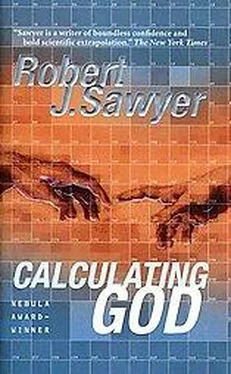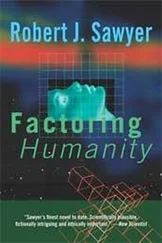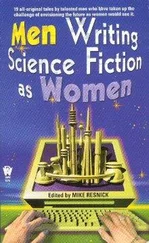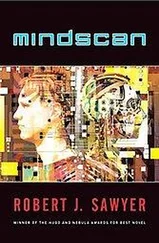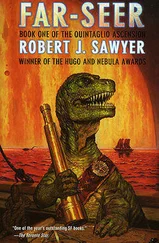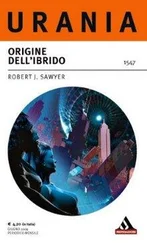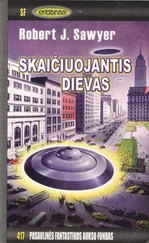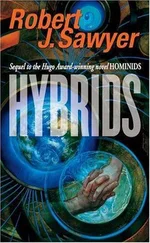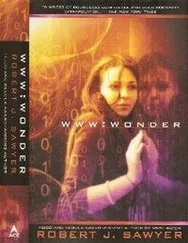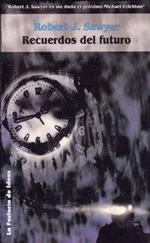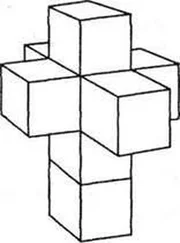Robert Sawyer - Calculating God
Здесь есть возможность читать онлайн «Robert Sawyer - Calculating God» весь текст электронной книги совершенно бесплатно (целиком полную версию без сокращений). В некоторых случаях можно слушать аудио, скачать через торрент в формате fb2 и присутствует краткое содержание. Город: New York, Год выпуска: 2000, Издательство: Tor Books, Жанр: Фантастика и фэнтези, на английском языке. Описание произведения, (предисловие) а так же отзывы посетителей доступны на портале библиотеки ЛибКат.
- Название:Calculating God
- Автор:
- Издательство:Tor Books
- Жанр:
- Год:2000
- Город:New York
- ISBN:нет данных
- Рейтинг книги:5 / 5. Голосов: 1
-
Избранное:Добавить в избранное
- Отзывы:
-
Ваша оценка:
- 100
- 1
- 2
- 3
- 4
- 5
Calculating God: краткое содержание, описание и аннотация
Предлагаем к чтению аннотацию, описание, краткое содержание или предисловие (зависит от того, что написал сам автор книги «Calculating God»). Если вы не нашли необходимую информацию о книге — напишите в комментариях, мы постараемся отыскать её.
Calculating God — читать онлайн бесплатно полную книгу (весь текст) целиком
Ниже представлен текст книги, разбитый по страницам. Система сохранения места последней прочитанной страницы, позволяет с удобством читать онлайн бесплатно книгу «Calculating God», без необходимости каждый раз заново искать на чём Вы остановились. Поставьте закладку, и сможете в любой момент перейти на страницу, на которой закончили чтение.
Интервал:
Закладка:
I decided not to contradict her about whether there was anything special about out planet. “I’m glad they’re here,” I said. “I’m glad they came to visit us.”
Christine yawned expansively — quite a sight with her horsey mouth, although she tried to hide it behind the back of her hand. It was getting late — and we’d only just begun. “Sorry,” she said when she was done. “I just wish there was some way to get Hollus to do some public programming here. We could—”
At that moment, Hollus rejoined us. “They are ready to do the first scan,” she said. “The equipment will run on its own, and it would be better if we all left the room to avoid vibrations.”
I nodded, and the six of us headed out into the Rotunda. “How long will the scan take?”
“About forty-three minutes for the first case,” said Hollus.
“Well,” said Christine, “no point just standing around. Why don’t we go have a look at some Far Eastern artifacts?” Those galleries were also on the first floor, rather close to our current location.
Hollus spoke to the three other aliens, presumably to get their consent. “That would be fine,” she said, turning back to us.
I let Christine take the lead; it was her museum, after all. We crossed the Rotunda diagonally again, passed the totem poles, and entered the T. T. Tsui Galleries of Chinese Art (named for the Hong Kong businessperson whose donation had made them possible); the ROM had the finest collection of Chinese artifacts in the western world. We passed through the galleries, with their cases full of ceramics, bronzes, and jades, and entered the Chinese Tomb area. For decades, the tomb had been located outside, exposed to Toronto’s weather, but now it was here, on the first floor of the ROM’s terrace galleries. The outside wall was glass, looking out on a slick, wet Bloor Street; a Pizza Hut and McDonald’s faced in from the other side of the road. The roof was tented skylights; raindrops beat against them.
The tomb components — two giant arches, two stone camels, two giant human figures, and the huge tumulus dome — had no velvet ropes around them. The other Forhilnor, Barbulkan, reached out to touch the carvings on the nearer archway with his six-fingered hand. I imagined that if you did a lot of work via telepresence, getting to really touch things with your own flesh-and-blood fingers was a special thrill.
“These tomb pieces,” said Christine, standing by one of the stone camels, “were purchased by the museum in 1919 and 1920 from George Crofts, a British fur trader and art dealer stationed in Tianjin. They supposedly come from the tomb complex at Fengtaizhuang in Hebei province and are said to belong to the famous Ming-dynasty general Zu Dashou, who died in 1656 AD.”
The aliens murmured among themselves. They were clearly fascinated; maybe they didn’t build monuments to their own dead.
“Chinese society at this time was shaped by the idea that the universe was a highly ordered place,” continued Christine. “The tomb and tomb figures here reflect this idea of a structured cosmos, and—”
At first I thought it was thunder.
But that wasn’t it.
A sound was ripping through the tomb area, echoing loudly off the stone walls.
A sound I’d only ever heard before on TV and in the movies.
The sound of rapid gunfire.
Foolishly, we ran from the tomb toward the sound. The Forhilnors easily outpaced us humans, and the Wreeds brought up the rear. We hurried through the T. T. Tsui Galleries and out into the darkened Rotunda.
The sound was coming from the Garfield Weston Exhibition Hall — from the Burgess Shale exhibit. I couldn’t imagine who was being shot at: besides the security guard at the staff entrance, we were the only people in the building.
Christine had a cellular phone with her; she’d already flipped it open and was presumably dialing 9-1-1. Another volley of gunfire split the air, and here, closer, I was able to discern an additional, more familiar sound: rock shattering. I suddenly realized what was happening. Somebody was shooting at the priceless, half-billion-year-old Burgess Shale fossils.
The gunfire stopped just as the Wreeds were arriving in the Rotunda. We had hardly been quiet: Christine was talking into her cellular, our footfalls had echoed in the galleries, and the Wreeds, utterly mystified — maybe they had never developed projectile weapons — were chatting animatedly to each other despite my attempts to shush them.
Even partially deafened by the sound of their own gunfire, the people shooting up the fossils evidently heard the sounds we had made. First one and then another emerged from the Exhibition Hall. The one who came out first was covered with wood chips and rock fragments, and he was holding some sort of semiautomatic weapon — a submachine gun, maybe. He aimed it at us.
That, at last, was enough to get us to do the sensible thing. We froze. But I glanced over at Christine and made a questioning face, silently asking whether she’d gotten through to the 9-1-1 operator. She nodded yes, and tipped the case of her cellular just enough so that I could see by its glowing faceplate that she was still connected. Thank God the emergency operator had had the good sense to fall silent as soon as Christine had.
“Holy God,” said the man holding the gun. He half turned to face his younger partner, who had a crew cut. “Holy God, will you look at them things?” He had an accent from the southern U.S.
“Aliens,” said the man with the crew cut, as if trying on the word for size; he had a similar accent. Then, a moment later, deciding that the word indeed fit, he said it again, more forcefully. “Aliens.”
I took a half-step forward. “They’re projections, of course,” I said. “They’re not really here.”
The Forhilnors and Wreeds might have different ways from humans, but at least they weren’t fool enough to contradict me.
“Who are you?” asked the man with the gun. “What are you doing here?”
“I’m Thomas Jericho,” I said. “I’m the head of the paleobiology department here at” — I raised my voice as much as I dared, hoping the 9-1-1 operator would pick up my words, in case Christine hadn’t yet conveyed to him or her where we were — “the Royal Ontario Museum.” Of course, by this point the museum’s own overnight security guard must have realized something was up and had presumably also called the cops.
“No one should be here this time of night,” said the man with the crew cut.
“We were taking some photographs,” I said. “We wanted to do it when the museum was empty.”
Maybe twenty meters separated our group from the two of them. There might have been a third or fourth intruder inside the exhibit hall, but I’d seen no sign of that.
“What, may I ask, are you doing?” asked Christine.
“Who are you?” asked the man with the gun.
“Dr. Christine Dorati. I’m the director of the museum. What are you doing?”
The two men looked at each other. The guy with the crew cut shrugged. “We’re destroying those lying fossils.” He looked at the aliens. “You aliens, y’all have come to Earth, but you’re listening to the wrong people. These scientists” — he almost spat the word — “are lying to you, with their fossils and all. This world is six thousand years old, the Lord created it in just six days, and we are his chosen people.”
“Oh, God,” I said, invoking the entity they believed in but I did not. I looked at Christine. “Creationists.”
The man with the submachine gun was growing impatient. “Enough,” he said. He aimed the gun at Christine. “Drop that phone.”
She did so; it hit the marble floor with a clang and its flip-down mouthpiece broke free.
Читать дальшеИнтервал:
Закладка:
Похожие книги на «Calculating God»
Представляем Вашему вниманию похожие книги на «Calculating God» списком для выбора. Мы отобрали схожую по названию и смыслу литературу в надежде предоставить читателям больше вариантов отыскать новые, интересные, ещё непрочитанные произведения.
Обсуждение, отзывы о книге «Calculating God» и просто собственные мнения читателей. Оставьте ваши комментарии, напишите, что Вы думаете о произведении, его смысле или главных героях. Укажите что конкретно понравилось, а что нет, и почему Вы так считаете.
